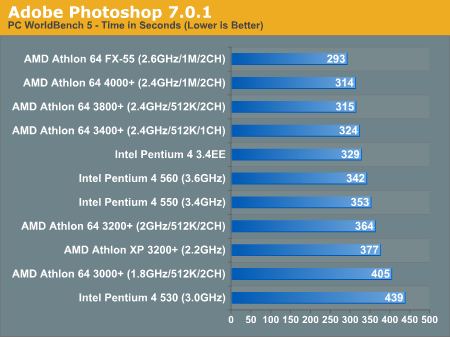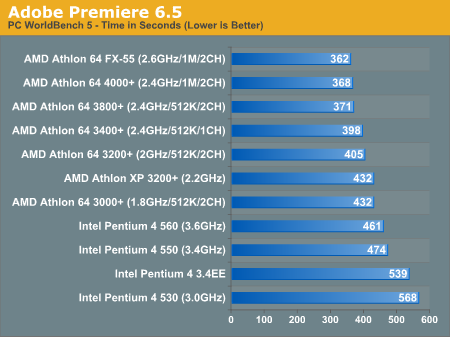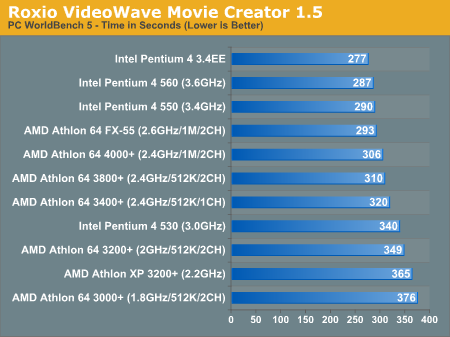AMD Athlon 64 4000+ & FX-55: A Thorough Investigation
by Anand Lal Shimpi on October 19, 2004 1:04 AM EST- Posted in
- CPUs
Video Creation/Photo Editing
Adobe Photoshop 7.0.1
With the later releases of the Athlon XP, AMD began to offer fairly solid performance in Photoshop but with the Athlon 64 AMD managed to seal their fate - making AMD the platform of choice for Photoshop users.
The Top four spots in WorldBench's Photoshop 7 test are won by AMD, first by the 2.6GHz FX-55 and then by the three chips at 2.4GHz. As we've seen in the past, image editing doesn't benefit all that much from high bandwidth memory subsystems, so there's little benefit from a larger cache (0.3%) or from a dual channel memory setup (2.7%).
Despite its higher clock speed, the Pentium 4 560 takes a back seat to the Extreme Edition, justifying the EE's continued presence for a little while longer. Though with plans for a Pentium 4 4GHz scrapped, it seems like we'll be seeing a lot more of the Extreme Edition.
Athlon XP owners will find little reason to upgrade to an entry-level Athlon 64 for Photoshop use, as the two 3200+s manage to perform very similarly despite architecture and clock speed differences.

Adobe Premier 6.5
Prescott seems to do quite a bit for Intel here, with the 560 and 550 easily offering better performance than the 3.4EE, despite smaller caches. That being said, even the top of the line Pentium 4 560 can't outperform even the Athlon XP 3200+ in this test. While WorldBench does use an older version of Premier, it is one that is still widely used, making these results quite pertinent.
Once again we see very little need for the larger cache of the Athlon 64 4000+, but more of a tangible benefit from the move to Socket-939 from Socket-754 (6.7%).
AMD simply dominates this test; Premier users should know what platform is right for their needs.

Roxio VideoWave Movie Creator 1.5
While Premier is a wonderful professional application, consumers will prefer something a little easier to use. Enter: Roxio's VideoWave Movie Creator, a fairly full featured yet consumer level video editing package.
Intel has worked very closely with Roxio in the past, thus it's no surprise to see Movie Creator take advantage of the Prescott core as best as possible. The Extreme Edition still takes the crown, but the 560 and 550 manage to keep AMD's best at bay.
The Athlon 64 FX-55 is still within striking distance of the 3.4EE at only a 5% deficit, but the gap grows as we look at cheaper AMD solutions. Intel wins here with AMD in a close second.











89 Comments
View All Comments
skiboysteve - Tuesday, October 19, 2004 - link
On the Business winstone 2004..."The Pentium 4 550 and Athlon 64 3800+ tie in the middle, while the 3400+ offers statistically similar performance."
No they didnt.
microAmp - Tuesday, October 19, 2004 - link
Very nice article, loved the L2 cache and memory comparisons at the end.thermalpaste - Tuesday, October 19, 2004 - link
Way back in 2000, I felt that Intel was doing something stupid by introducing the Willamette.The thunderbird was faster than the p-III coppermine at the same clock speeds, but considering that the p-III just had 2 parallel FPUs compared to the 3 on the athlon. An additional FPU would have helped of course. though the P-III core was not able to sustain higher clock speeds , intel could have redesigned a marginally deeper pipeline on the same core rather than designing the pentium-4 with a mammoth 20 stage pipeline.
Now the prescotts come with a 30-odd stage pipeline, but the integer unit runs at twice the speed which doesn't make the 7th generation of processors from intel very 'scalable'. Besides the processor heats upto 70 odd degrees with consummate ease (Im staying in India where the avg. room temperature is something like 29 degrees Celsius) and is not overclocker friendly.
I am waiting for the newer chips from Intel, based on the Pentium-M a.k.a the P6 architecture.
AMD is way ahead of Intel as of now.
skiboysteve - Tuesday, October 19, 2004 - link
Athlon 64 4000+ - 2.4GHz - 1MB - 128-bitAthlon 64 3800+ - 2.4GHz - 512KB - 128-bit
Athlon 64 3400+ - 2.4GHz - 1MB - 64-bit
Athlon 64 3400+ - 2.4GHz - 512KB - 64-bit
Athlon 64 FX-53 - 2.4GHz - 1MB - 128-bit
these numbers look off.
Your saying there are two s754 3400+, and one has more cache?
eva2000 - Tuesday, October 19, 2004 - link
why leave out the 3700+ s754 1MB from suhc a nice comparison :)miketheidiot - Tuesday, October 19, 2004 - link
excellent article. I agree with #2 that I would have liked to see an overclocking comparison, or at least a quick demonstation of the 4000 and fx-55. Still a great article though.GhandiInstinct - Tuesday, October 19, 2004 - link
We can always marvel at them but the prices, realistcaly speaking is a waste of our time. I'm as interested in the FX-55 as much as the IBM super-computer blue.Zac42 - Tuesday, October 19, 2004 - link
I especially liked the comparrison of the equally priced value procs at the end of the article. Nice way to sum up the graphs. Good overall comparison, as you guys have just about any possible app one could use on a PC. Now we just need an OC comparrison, and we will be set!DrMrLordX - Tuesday, October 19, 2004 - link
Nice article so far, still reading it, but I would like to know where the 925XE chipset-based P4 board was in this review? Are those available to you guys yet? Just wondering.